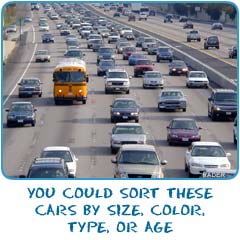
Identifying Traits
Even though identifying traits is not specifically about colors or shapes, it is an important idea in this section. Before you dive into math, you need to practice your observation skills. Sure it's easy to start counting objects, but what happens when the question looks at color, shape, number, and sizes? You need to be ready to work your way through a variety of characteristics to find the correct set or value you need.Physical Traits
Most physical traits are obvious when you are looking at objects. What color is it? Is it rough or smooth? If you hit it with a hammer, does it shatter or does nothing happen? What shape is it? These are all physical traits you will need to recognize. Those are the easy ones. If you have a bowl full of candies and someone tells you to pull out all of the red candies, you go for it. If they say to pull out all of the gummy candies, that's another physical trait. You get the idea There are also physical traits that are not easy to see. If you decide to learn more about science, you will learn about ideas that include melting point or conductivity. While a bit advanced for this page, the melting point is the temperature where a solid will melt and become a liquid. Conductivity measures the amount of electricity and object can pass from one point to another. These physical traits are not as easily seen, but they are still there.
There are also physical traits that are not easy to see. If you decide to learn more about science, you will learn about ideas that include melting point or conductivity. While a bit advanced for this page, the melting point is the temperature where a solid will melt and become a liquid. Conductivity measures the amount of electricity and object can pass from one point to another. These physical traits are not as easily seen, but they are still there.
Chemical Traits
We've built a bunch of science websites, so we would be neglecting our duties if we ignored chemical traits. While you probably won't be asked about chemical traits on your math tests, you need to remember that those traits are important if you enter the world of science. You need to think about whether certain materials will bond with other materials. Will a certain substance burn when you hold it over a flame? Paper will burn. Fabrics will burn. Did you know that sugar will also burn? That's important to know. Maybe that chemical trait of being flammable is important when you are grouping objects. Just know that chemical traits are another way of categorizing objects and materials.Comparisons
So someone tells you to pull out the red candies. But what if they say you need to pull out the five biggest red candies? On top of physical and chemical traits are the comparisons you will need to make. This apple is bigger than that apple. This cherry is a darker red than that cherry. That lemon is sweeter than the other lemon. All of these examples are ideas of identifying a trait and then comparing the object to another that has similar traits.Example:
Smallest (only one can be smallest) -- Smaller -- Larger -- Largest (only one can be largest)
As you go on to learn more about the world, you will find that very few natural things are identical. One will always be bigger or smaller. One will always be more colorful or less colorful. One will always be faster or slower. That variety is all around you. Many math problems will ask you to compare those traits. So be ready.
Related Activities

|
Comparing Traits Activity
- Play Activity |

|
Web Colors Memory Challenge
- Play Activity |
Useful Reference Materials
Wikipedia:https://en.wikipedia.org/wiki/Pre-algebra
Encyclopædia Britannica:
http://www.britannica.com/topic/mathematics
College of the Redwoods:
http://mathrev.redwoods.edu/PreAlgText/





